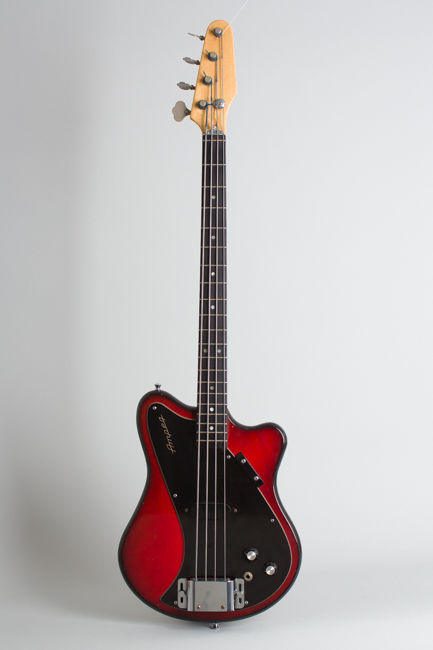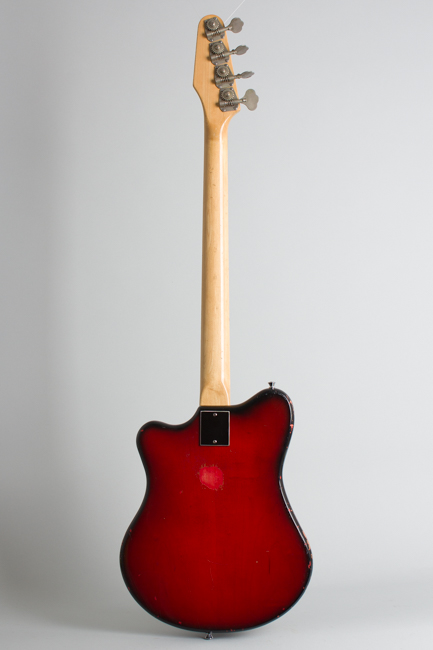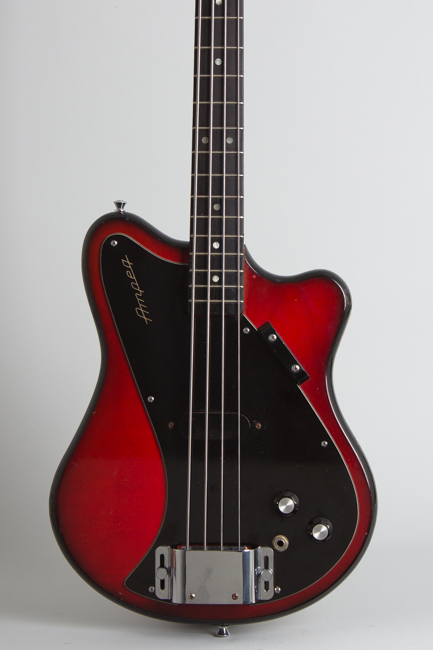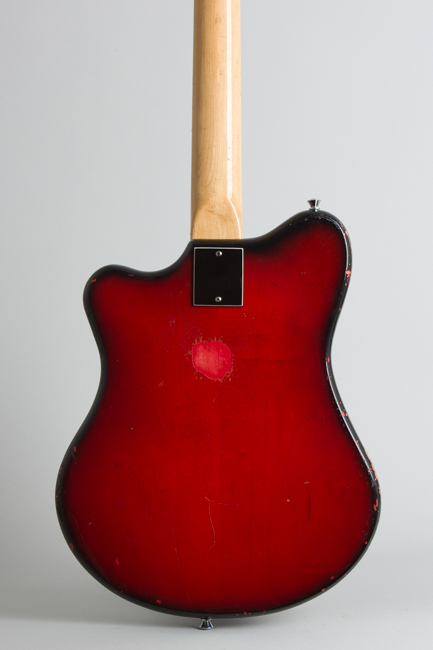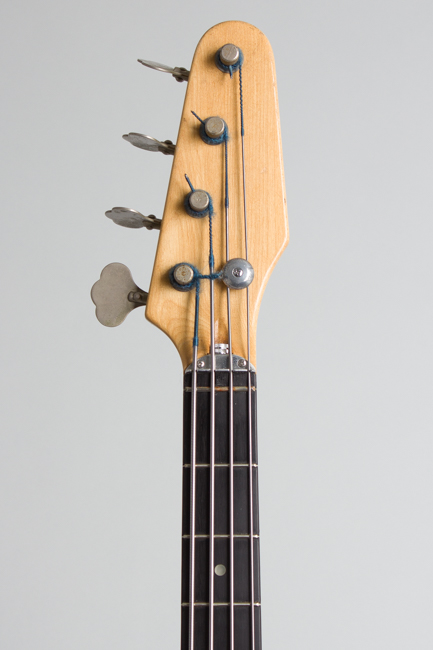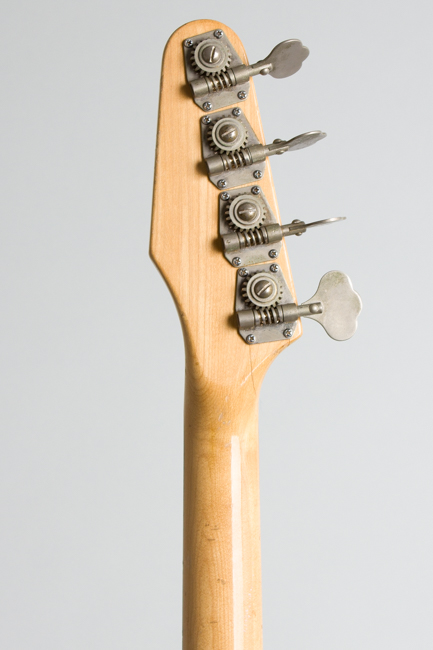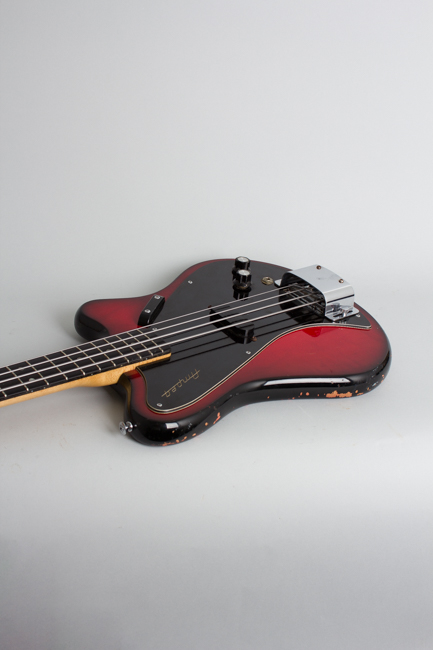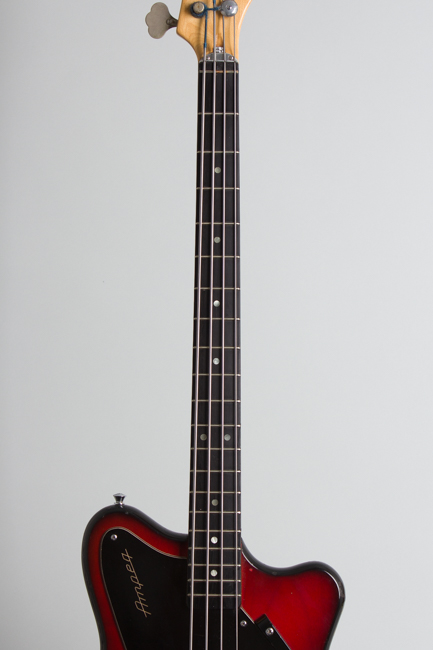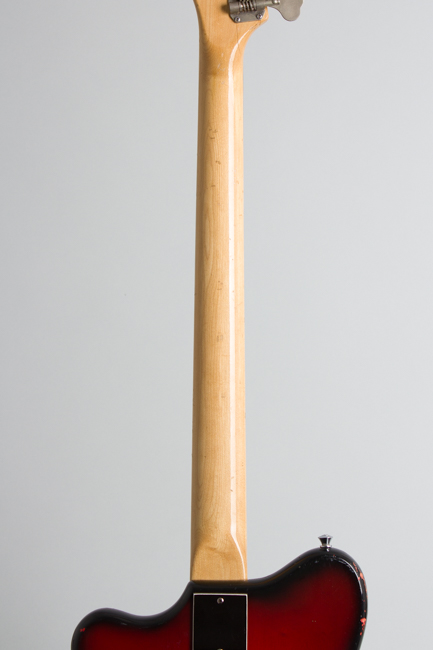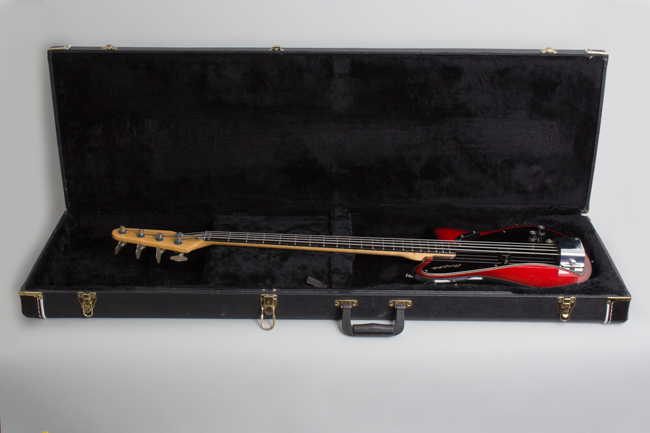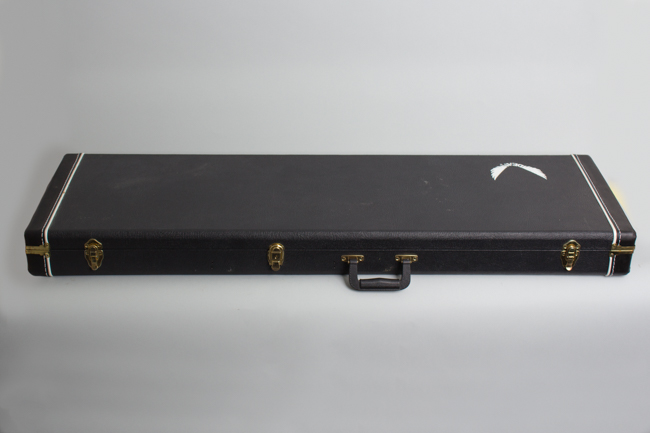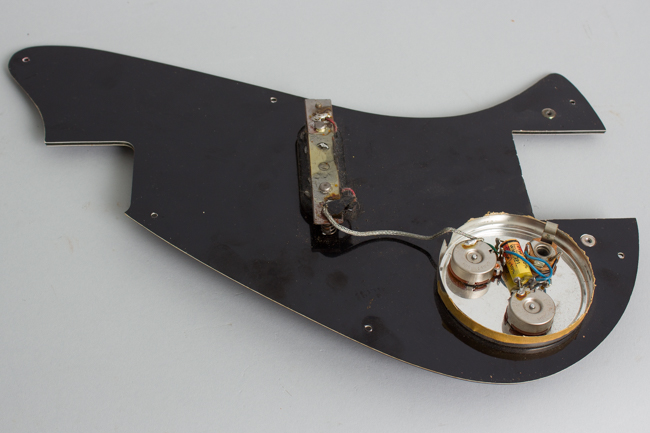Ampeg SSB-1 Electric Bass Guitar (1967)
This item is currently on hold.
Item # 12398
Prices subject to change without notice.
Ampeg SSB-1 Model Electric Bass Guitar (1967), made in Linden NJ, serial # 0214, red/black sunburst finish, laminated maple body, maple neck with ebony fingerboard, black hard shell case.
This is one of the rarest and coolest of all Ampeg products, the very short-lived Model SSB, or Short Scale Bass. Little seen except in the hands of Television's Fred Smith "back in the day" (Hi Fred!) this is an instrument even many dedicated Ampeg fans and bass collectors have never seen. This example shows some wear and repair but remains all original even down to the strings.
Ampeg introduced this model around the fall of 1967, about a year after their full-scale "Scroll Basses" hit he market. Compared to that elaborate and fairly expensive instrument the SSB was aimed at students and beginners, direct competition being the Fender Mustang Bass, Gibson Melody Maker Bass and many imported lower priced European and Japanese basses. The SSB was offered fretted and even unfretted (as the SSUB) which with its plain unmarked fingerboard would have been rather a challenge for most beginning players!
Compared to the large full-scale Ampeg basses the SSB is very small and handy, not much larger than most electric guitars. The bolt-on natural-finish maple neck has a 30 1/2" scale topped with a dot inlaid ebony fingerboard, a lavish touch for a student instrument. The single-sided headstock is vaguely "A" shaped, but also looks sort of like a Fender with some of the frills milled off! The excellent truss rod system and zero fret/metal spacer nut are shared with the full-scale Ampegs. The Kluson tuners are from the same stock as well, with large unfluted barrels intended for the side-mounted scroll headstock.
The small solid maple body has a Burns inspired red/black sunburst like its larger siblings topped with a cool sweeping wave-shaped pickguard. The Ampeg logo is engraved into the layered hard plastic on the upper horn and a single fingerrest is mounted off the bottom edge. The bridge is rather heavy duty with a one-piece adjustable metal saddle under the same sliding cover/mute housing used on the larger basses. The most interesting feature is the novel four-coil magnetic pickup, an early version of the unit that would appear on the AMB-1 in 1968.
Unfortunately the SSB and SSUB models appear to have been discontinued almost immediately after they were introduced. Listed at about half the price of an AEB-1, they were still more expensive than the most competing student basses. Ampeg's new management probably judged these models not worth the manufacturing effort and the company's changing priorities in this transitional period (after recently being sold) were directed elsewhere. Rather a shame in retrospect, as these are extremely well-engineered and fun basses to play, super handy retaining a good punchy tone compared to many other short scale models.
These basses are very rare; it appears that there was only one short production run around November 1967; the pots in this bass are stamped 137-6737. Ampeg bass expert/historian Bruce Johnson has researched the serial numbers on SSB and SSUB models and reports they mostly range from #0195 to #0223 for production models (this one is #214). He estimates that only around 40 were built split between fretted SSBs and fretless SSUBs. We have never had one before, and this slightly worn in but all-original example is a delightful instrument we are thrilled to offer for the first time.
Overall length is 43 in. (109.2 cm.), 13 in. (33 cm.) wide at lower bout, and 1 1/4 in. (3.2 cm.) in depth, measured at side of rim. Scale length is 30 1/2 in. (775 mm.). Width of nut is 1 5/8 in. (41 mm.).
This bass is a very nice player with general wear overall and one small repair, but remains original as built in 1967. The original finish on the face has light checking and some small dings; the sides have a larger number of dings and chips, some of which were carefully filled in. The back of the body has dings, dents, heavier scratching and a spot of buckle wear through the finish lightly into the wood. The back of the neck has a number of small dings and dents but no major wear.
The back of the headstock shows two small lateral repaired splits to the wood each coming off the lowest tuner screws; these are solidly sealed with no overfinish. This is not an ongoing structural issue and these do not extend beyond the tuner, or around to the front of the peghead. There are no other visible repairs. The original frets show virtually no wear, the bass is still strung with original LaBella flatwound strings we would assume it came with when new. All the hardware is original and intact; even the sliding bridge cover (usually missing) is still present. The foam mute pads originally mounted beneath it are gone but could easily be replaced. This is a lovely playing little bass, superbly easy to handle with a super true period sound thanks mainly to the original strings. It lives in a more modern HSC. Overall Very Good + Condition.
This is one of the rarest and coolest of all Ampeg products, the very short-lived Model SSB, or Short Scale Bass. Little seen except in the hands of Television's Fred Smith "back in the day" (Hi Fred!) this is an instrument even many dedicated Ampeg fans and bass collectors have never seen. This example shows some wear and repair but remains all original even down to the strings.
Ampeg introduced this model around the fall of 1967, about a year after their full-scale "Scroll Basses" hit he market. Compared to that elaborate and fairly expensive instrument the SSB was aimed at students and beginners, direct competition being the Fender Mustang Bass, Gibson Melody Maker Bass and many imported lower priced European and Japanese basses. The SSB was offered fretted and even unfretted (as the SSUB) which with its plain unmarked fingerboard would have been rather a challenge for most beginning players!
Compared to the large full-scale Ampeg basses the SSB is very small and handy, not much larger than most electric guitars. The bolt-on natural-finish maple neck has a 30 1/2" scale topped with a dot inlaid ebony fingerboard, a lavish touch for a student instrument. The single-sided headstock is vaguely "A" shaped, but also looks sort of like a Fender with some of the frills milled off! The excellent truss rod system and zero fret/metal spacer nut are shared with the full-scale Ampegs. The Kluson tuners are from the same stock as well, with large unfluted barrels intended for the side-mounted scroll headstock.
The small solid maple body has a Burns inspired red/black sunburst like its larger siblings topped with a cool sweeping wave-shaped pickguard. The Ampeg logo is engraved into the layered hard plastic on the upper horn and a single fingerrest is mounted off the bottom edge. The bridge is rather heavy duty with a one-piece adjustable metal saddle under the same sliding cover/mute housing used on the larger basses. The most interesting feature is the novel four-coil magnetic pickup, an early version of the unit that would appear on the AMB-1 in 1968.
Unfortunately the SSB and SSUB models appear to have been discontinued almost immediately after they were introduced. Listed at about half the price of an AEB-1, they were still more expensive than the most competing student basses. Ampeg's new management probably judged these models not worth the manufacturing effort and the company's changing priorities in this transitional period (after recently being sold) were directed elsewhere. Rather a shame in retrospect, as these are extremely well-engineered and fun basses to play, super handy retaining a good punchy tone compared to many other short scale models.
These basses are very rare; it appears that there was only one short production run around November 1967; the pots in this bass are stamped 137-6737. Ampeg bass expert/historian Bruce Johnson has researched the serial numbers on SSB and SSUB models and reports they mostly range from #0195 to #0223 for production models (this one is #214). He estimates that only around 40 were built split between fretted SSBs and fretless SSUBs. We have never had one before, and this slightly worn in but all-original example is a delightful instrument we are thrilled to offer for the first time.
Overall length is 43 in. (109.2 cm.), 13 in. (33 cm.) wide at lower bout, and 1 1/4 in. (3.2 cm.) in depth, measured at side of rim. Scale length is 30 1/2 in. (775 mm.). Width of nut is 1 5/8 in. (41 mm.).
This bass is a very nice player with general wear overall and one small repair, but remains original as built in 1967. The original finish on the face has light checking and some small dings; the sides have a larger number of dings and chips, some of which were carefully filled in. The back of the body has dings, dents, heavier scratching and a spot of buckle wear through the finish lightly into the wood. The back of the neck has a number of small dings and dents but no major wear.
The back of the headstock shows two small lateral repaired splits to the wood each coming off the lowest tuner screws; these are solidly sealed with no overfinish. This is not an ongoing structural issue and these do not extend beyond the tuner, or around to the front of the peghead. There are no other visible repairs. The original frets show virtually no wear, the bass is still strung with original LaBella flatwound strings we would assume it came with when new. All the hardware is original and intact; even the sliding bridge cover (usually missing) is still present. The foam mute pads originally mounted beneath it are gone but could easily be replaced. This is a lovely playing little bass, superbly easy to handle with a super true period sound thanks mainly to the original strings. It lives in a more modern HSC. Overall Very Good + Condition.
